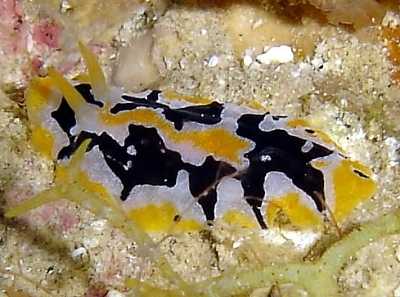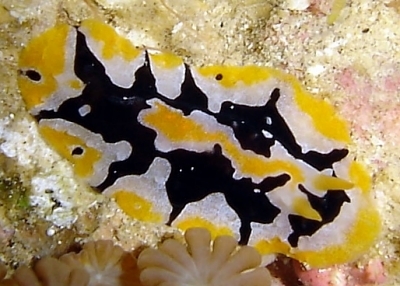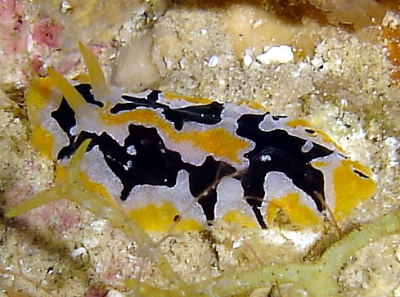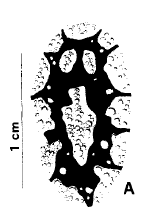

Phyllidiopsis monacha
(Yonow, 1986)
Order: NUDIBRANCHIA
Suborder: DORIDINA
Superfamily: EUDORIDOIDEA
Family: Phyllidiidae
DISTRIBUTION
Known only from the Red Sea
PHOTO
Locality: Eilat, Lighthouse Beach, 42m, Israel, Red Sea (Gulf of Eilat), 3 May 2006, coral reef. Length: 2cm. Photographer: Binyamin and Shulamit Koretz.
Phyllidia monacha Yonow, 1986 was described from a single preserved and decolourised specimen from the Red Sea [see message #19682]. Brunckhorst (1993) synonymized it with Phyllidiopsis dautzenbergi, presumably because the colour pattern of the preserved specimen [black pattern on whitish background] was very similar to the colour pattern of living P. dautzenbergi.
Binyamin & Shulamit Koretz's discovery of the animal figured here, suggest that Yonow's species is in fact distinctly different from P. dautzenbergi. The background colour is translucent white with a pattern of linked black patches down each side of the midline, each patch having Thin black streak running out to the mantle edge. Inside the black patches there is an irregularly shaped yellow median line. The rhinophores are yellow. The body and mantle are relativley flattened in shape and there appears to be no distinct median dorsal ridge. There are low rounded tubercles scattered over the mantle but rhinotubercles appear to be absent.
Although originally placed in the genus Phyllidia, Yonow gives no anatomical information to support that decision and it is not clear if Brunckhorst moved it to Phyllidopsis on anatomical grounds or simply because he considered a synonym of Phyllidiopsis dautzenbergi. The only character available from the photographs which can assist in generic placement is the absence of rhinotubercles, which are characteristic of Phyllidia and Fryeria. Yellow rhinophores, however, are characteristic of those two genera, but also occur in some species of Phyllidiopsis. Until specimens can be examined anatomically it is probably best to place this species in Phyllidiopsis.
This is a classic example of why it is best not to describe species from single, preserved, decolourised animals.
- Brunckhorst, D.J. (1993) The systematics and phylogeny of Phyllidiid Nudibranchs (Doridoidea). Records of the Australian Museum, Supplement 16: 1-107.
- Yonow, N. (1986) Red Sea Phyllidiidae (Mollusca: Nudibranchia) with descriptions of new species. Journal of Natural History 20 : 1401-1428.
- Yonow, N. (1988) Red Sea Opisthobranchia 1: The family Phyllidiidae (Mollusca, Nudibranchia). Fauna of Saudi Arabia 9: 138-151.
Rudman, W.B., 2007 (March 26) Phyllidiopsis monacha (Yonow, 1986). [In] Sea Slug Forum. Australian Museum, Sydney. Available from http://www.seaslugforum.net/find/phylmona
Related messages
Rediscovery of Phyllidiopsis monacha from the Red Sea
March 26, 2007
From: Binyamin Koretz


Dear Bill,
Sorry if this starts another Red Sea phyllidiid controversy, but we're pretty sure that this is Phyllidiopsis monacha (Yonow, 1986) [Phyllidia] which Brunckhorst (1993) synonymized it with P. dautzenbergi but it is obviously not P. dautzenbergi.
Locality: Eilat, Lighthouse Beach, 42m, Israel, Red Sea (Gulf of Eilat), 3 May 2006, coral reef. Length: 2cm. Photographer: Binyamin and Shulamit Koretz.
The problem obviously is that Yonow described the species from a single preserved specimen and there was no record of the colors of a living animal. The preserved animal was black and white except for "pale creamy orange pigmentation" retained at the gills. I have included a copy of Yonow's illustration (Fig 3A) [lower right ] to show that the pattern of black coloration in Yonow's holotype is sufficiently different from the pattern of typical P. dautzenbergi as to give one pause. In fact it matches our animal quite well, as you can see.
Best regards
Binyamin
binyamin@koretz.net
Koretz, B., 2007 (Mar 26) Rediscovery of Phyllidiopsis monacha from the Red Sea. [Message in] Sea Slug Forum. Australian Museum, Sydney. Available from http://www.seaslugforum.net/find/19682
Dear Binyamin,
As much as it would be nice to hide photos like this away, sometimes we just can't avoid controversies. This is a classic example of why it is best not to describe species from single, preserved, decolourised animals without any accompanying notes on the living animals or a photograph. I can see why Brunckhorst considered it to be a synonym of the black and white species P. dautzenbergi in which the black markings are very similar.
I guess the retention of some orange coloration in the gills of the preserved animal, as mentioned by Yonow, may suggest that the living animal has orange or yellow markings, but we really shouldn't have to be discussing 'ifs' and 'buts' when trying to identify recently described species. Another question is whether or not it is a species of Phyllidiopsis or not. It was described as a Phyllidia by Yonow but she gives no anatomical information to determine its real generic position and Brunckhorst, other than saying that he 'examined the holotype' gives no indication that he examined its anatomy. Perhaps after deciding it was just P. dautzenbergi, on external similarity, he assumed its internal anatomy was that of a Phyllidiopsis?
One difference between Phyllidia and Phyllidiopsis we can see in these photos is that Phyllidiopsis lacks the rhinotubercles found in species of Phyllidia. [a rhinotubercle is a small tubercle found just behind the rhinophore sheath in Phyllidia and Fryeria]. There are no sign of rhinotubercles in your photos which suggests it could be a species of Phyllidiopsis.
I am happy to go with the idea that this is P. monacha. Certainly the black markings are identical to Yonow's black & white drawing, and the yellow shows it is not P. dautzenbergi. This is an interesting find
Best wishes,
Bill Rudman
